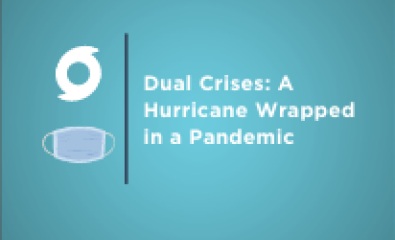
Dual Crises: A Hurricane Wrapped in a Pandemic
Today we mourn the loss of life and begin to see the catastrophic damage caused by Hurricane Laura. Compounding this devastation is the COVID-19 pandemic.
This unfolding crisis is horrific and traumatic for everyone affected, regardless of class, race, age, and disability. Even as we care for all of those affected, the reality is that disasters, including catastrophic Category 4 hurricanes, do not affect everyone equally. Low-income neighborhoods and Black and Latinx communities, because of pre-existing disparities in infrastructure, property values, storm protection, geographic and social vulnerability, and exposure to environmental hazards, are more adversely affected and have a harder time recovering from a disaster. Research shows that wealthier, whiter communities disproportionately benefit from federal disaster recovery benefits, including FEMA funding, disaster SBA loans, and buyout programs. Public funds intended for broad-based recovery actually increased the concentration of wealth.
Three years after Hurricane Harvey, there are still families from Corpus Christi to Port Arthur whose homes have not been rebuilt, whose neighborhoods don’t have protective infrastructure, who remain displaced from their communities, and who are still struggling to rebuild their lives; many of these communities are now facing Hurricane Laura.
The ongoing crisis of structural racism and economic inequality has not only put these communities in harm’s way, it has deprived them of the resources to recover. Port Arthur, for example, was devastated by Hurricane Harvey, but then denied sufficient funding when the South East Texas Regional Planning Commission (SETRPC) created its own funding allocation formula for CDBG-DR funds instead of following the federal regulations. The three cities in the SETRPC region with the highest percent Black non-Latinx populations (Beaumont, Port Arthur, and Orange), and the highest number of damaged owner-occupied homes, were the cities that received the lowest per capita funding for buyouts. Unincorporated areas of Orange, Hardin and Jefferson County were also underfunded. Port Arthur, 55,000 people, almost 80% Black and Latinx with a poverty rate of 27% and 90% of its population impacted by Harvey, was allocated $71 per home. Taylor Landing, 287 people, 87.3% non-Hispanic White, with a poverty rate of 0% and 9% of its population impacted, was allocated $151,495.45 per home. This formula, like FEMA’s undercount of affected renters, basing buyout offers on pre-storm market value, and basing cost-benefit analyses for infrastructure on property value and not people protected, has a disparate racial impact, and pushes communities of color, low-income communities, and often rural communities, further into poverty and increased vulnerability to disasters.
We can also see the disproportionate impact that the COVID-19 pandemic is having on Black and Latinx communities, low-wage frontline workers, and people who are homeless. Not only are Black and Latinx Americans more likely to contract COVID-19, they are more likely to die from it. Renter households and households of color are more likely to have lost income because of COVID-19, and are at higher risk of eviction, particularly if they have children. As unemployment grows, more and more Texans will find themselves struggling to survive and get the resources they need to stay healthy and to recover from Hurricane Laura.
The American disaster recovery system was designed for households with insurance and other resources who just needed temporary help; not for Americans who were already struggling. Disaster recovery funds have, in fact, provided more benefits to wealthier and whiter areas and homeowners, increasing economic inequality and the racial wealth gap.
It is particularly urgent during the COVID-19 pandemic, when lack of access to money, food, housing, and medical care for vulnerable populations is critical to protecting the health of everyone, that Texans have as many resources as possible to prevent the virus from spreading and to recover from Hurricane Laura and any subsequent disasters.
Disproportionate impact and lack of resources for the families most in need has always been a problem following disasters, but the COVID-19 pandemic means not only that more Texans are struggling economically, but that many of the public systems that respond in a disaster — from healthcare to unemployment insurance — are also struggling. The pandemic is a nationwide disaster, which will also reduce the help available from other parts of the country. The National Disaster Recovery framework places primary responsibility on the shoulders of state and local government, but COVID-19 means that they have fewer resources for disaster response and recovery.
Texas needs to ask hard questions regarding the current disaster response and recovery, and how we prepare for a future of more frequent and powerful storms:
-
Are local governments focused on evacuating the most at-risk families and neighborhoods?
-
Are emergency warnings and information about evacuations and relief programs being provided in all the languages local residents speak?
-
How are responders arranging shelter and evacuation to minimize the spread of COVID-19? Are they utilizing non-congregate shelters?
-
How are institutions with high levels of COVID-19 cases like nursing homes and jails being evacuated?
-
Are PPE and COVID-19 related supplies part of the supplies FEMA and other agencies will distribute?
-
Are there long-term housing plans if people cannot return to their communities for weeks or months?
-
How will jurisdictions deal with the needs of people who are homeless as the eviction crisis continues, and with decreased access to federal help?
-
Is the state requesting all the help it is entitled to under a disaster declaration — not just debris removal and repair of government buildings, but housing assistance, disaster unemployment benefits, disaster food stamps, and disaster legal assistance?
-
How can we ensure recovery is based on people and not property value?
-
Are people and communities of color, and individuals with disabilities incorporated into every step of the planning, response, and recovery process?
We know Texas will rebuild, and we send Texans, those in Louisiana, and other affected areas strength as the storm continues. The question we must answer is whether recovery is just and makes all Texans more resilient to the disasters that may affect them.